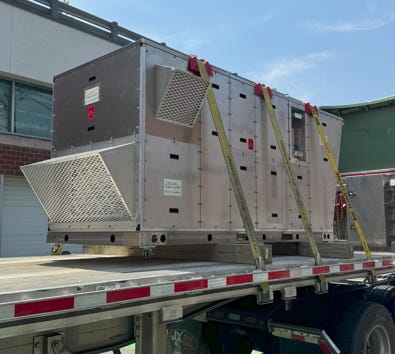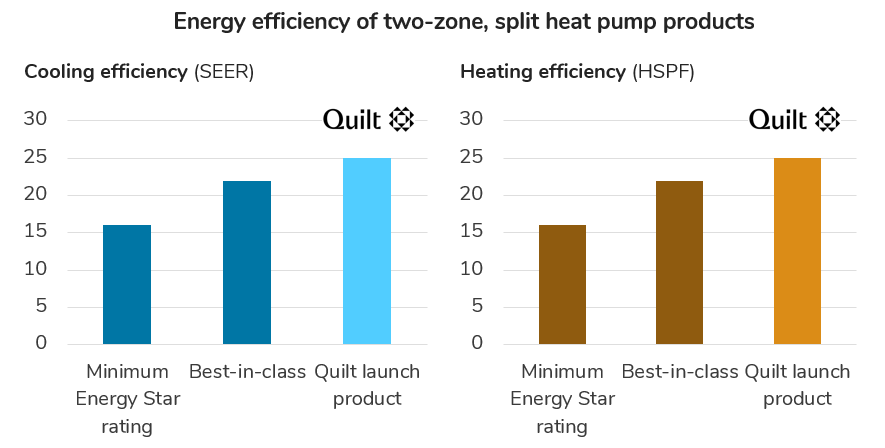Today’s charts come from two of our portfolio companies at Energy Impact Partners who have been hard at work building better systems for heating, ventilation, and air conditioning - aka HVAC.
The first is from Transaera, which recently completed testing and installation of its first product, a class of HVAC system called a Dedicated Outdoor Air System (or DOAS), on a real customer building. One of the primary functions of a DOAS is bringing fresh, outdoor air into a building while simultaneously dehumidifying that air.
When it comes to dehumidifcation efficiency, Transaera blows incumbent solutions out of the water.
Transaera accomplished this leap forward in dehumidification efficiency via the clever application of novel materials. Specifically, the company is employing a class of material called a “metal organic framework”, or a “MOF”. MOFs are new & exciting, but this product is deliberately not. It’s a drop-in replacement for a DOAS in most commercial buildings. It’s roughly the same size and weight as today's commercial systems, and doesn't require any special accommodations to install. This thing boasts an exceptionally strong improvement in performance considering how little additional complexity it requires.
For reference, here’s a photo of Transaera’s DOAS preparing to be shipped off to a customer. It’s kind of a boring picture, because it looks just like any other DOAS. That’s the point!
Today’s second chart comes from Quilt, which also recently completed official testing for its launch product, a two-zone “mini split” heat pump.
I really can’t overemphasize how remarkable this is. Quilt is a two year old startup company which managed to build the most efficient mini-split on the market… and this data doesn’t even account for the fact that Quilt comes with sensing, controls, and intelligence which makes the product even more efficient. Oh, and by the way, the Quilt team achieved this feat while also designing the product to be physically smaller (so it fits in more spaces) and waaaaay more attractive than the standard beige boxes which you probably associate with heat pumps.
Notes:
I’m convinced that step-changes in HVAC efficiency are some of the biggest levers we have for smoothing the global path to decarbonization. Heating and cooling efficiency are both crucial, albeit for different reasons…
Cooling: The world is getting hotter and richer. Also, population growth is concentrated in places where it’s already hot, and where the most people are rising into the global middle class. Unsurprisingly, air conditioning is one of the first “luxury” goods which middle class people in hot climates tend to purchase. This appears to be one of those social phenomena that’s practically a natural law…
Hence, the International Energy Agency’s baseline outlook for global cooling demand forecasts adding an entire US electricity sector worth of new demand by mid-century. Damn.

Source: IEA, “The Future of Cooling: Opportunities for energy efficient air conditioning”, IEA, May 2018 Heating: In cooler climates, including about half of North America and Europe, heating our buildings consumes more energy than cooling them. In the US, for example, roughly 4% of all primary energy is used for cooling, while 13% is used for space & water heating. All roads to decarbonizing this heat without compromising affordability require higher efficiency solutions. (Last year, I inadvertently ended up writing a treatise on this topic.)
Heat pumps are one of the building blocks of the modern world. Hundreds of millions of them are manufactured every year in a wide variety of form factors, from refrigerators, to central air conditioners, to mini splits. Yet, remarkably, companies like Transaera and Quilt are proving that there’s still plenty of room for improvement.
For the past 15 years, energy efficiency has been defined by just three letters: LED. Anyone who cares about efficiency, from real estate sustainability officers to utility program managers, has been able to lean heavily on LED lighting in order to meet their goals. But as the number of light bulbs left to swap out begins to dwindle, I’m convinced that HVAC is going to take over as the next frontier for building efficiency.








